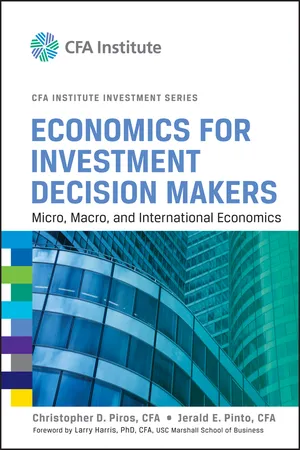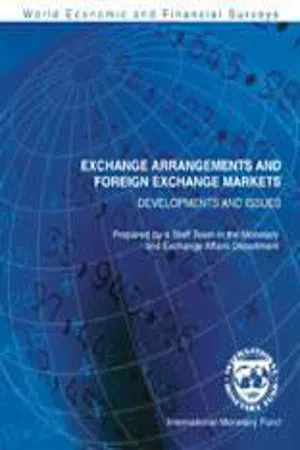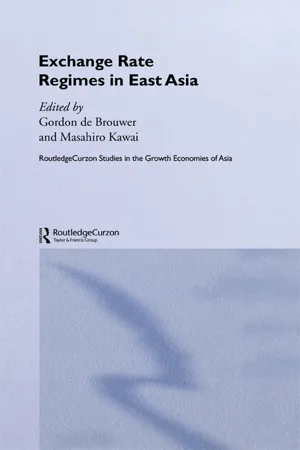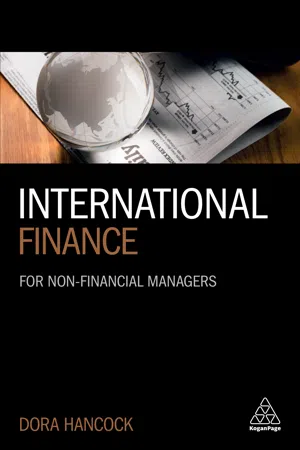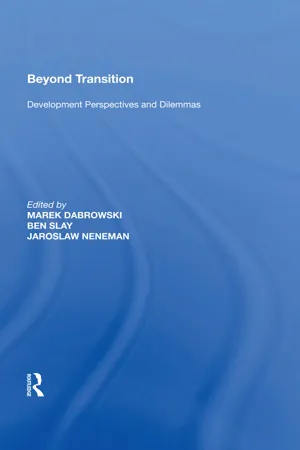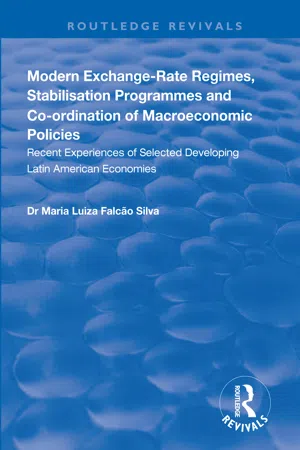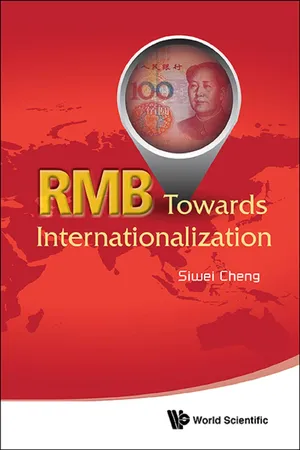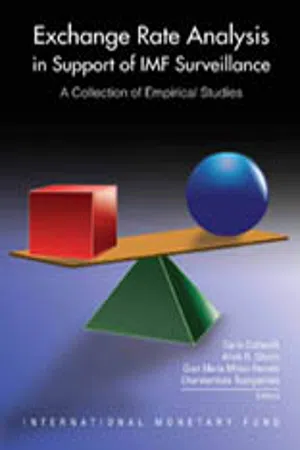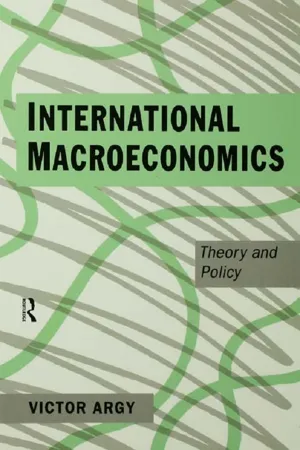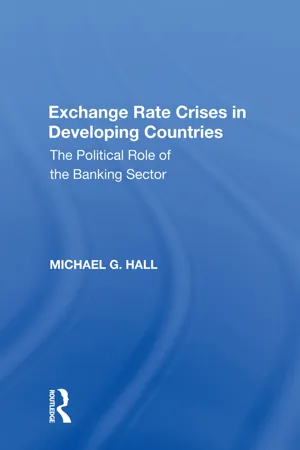Economics
Exchange Rate Regime
Exchange rate regime refers to the system used by a country to manage its currency in relation to other currencies. It can be fixed, floating, or a combination of both. In a fixed regime, the value of the currency is tied to a specific reference currency, while in a floating regime, the currency's value is determined by market forces.
Written by Perlego with AI-assistance
Related key terms
11 Key excerpts on "Exchange Rate Regime"
- eBook - ePub
Economics for Investment Decision Makers
Micro, Macro, and International Economics
- Christopher D. Piros, Jerald E. Pinto(Authors)
- 2013(Publication Date)
- Wiley(Publisher)
14 The hope was that the common currency would increase transparency of prices across borders in Europe, enhance market competition, and facilitate more efficient allocation of resources. The drawback, of course, is that each member country lost the ability to manage its exchange rate and therefore to engage in independent monetary policy.4.3. A Taxonomy of Currency Regimes
Although the pros and cons of fixed and flexible Exchange Rate Regimes continue to be debated, many countries adopt regimes that lie somewhere between these polar cases. Countries adopt specific regimes for a variety of reasons. In some cases, the driving force is the lack of credibility with respect to sound monetary policy. A country with a history of hyperinflation may be forced to adopt a form of fixed-rate regime because its promise to maintain a sound currency with a floating rate regime would not be credible. This has been a persistent issue in Latin America. In other cases, the driving force is as much political as economic. The decision to create the euro was strongly influenced by the desire to enhance political union within the European Community, whose members had been at war with each other twice in the twentieth century.As of April 2008, the International Monetary Fund (IMF) classified the actual (as opposed to officially stated) Exchange Rate Regimes of its members into the eight categories shown in Exhibit 9-8 .It should be noted that global financial markets are too complex and diverse to be fully captured by this (or any other) classification system. A government’s control over the domestic currency’s exchange rate will depend on many factors—for example, the degree of capital controls used to prevent the free flow of funds in and out of the country. Also, even those countries classified as using an independent float regime will occasionally intervene in foreign exchange markets in order to influence the value of their domestic currency. Additionally, the specifics of exchange rate policy implementation are subject to change. (For example, the Chinese yuan was officially pegged against a basket of currencies prior to the 2008 crisis in the global financial market, but the Chinese government switched back toward focusing on the rate against the U.S. dollar after market volatility rose.) - International Monetary Fund(Author)
- 2003(Publication Date)
- INTERNATIONAL MONETARY FUND(Publisher)
The remainder of this chapter discusses whether Exchange Rate Regimes based on members’ de facto policies have shifted away from intermediate regimes toward hard peg or floating regimes since 1990 and, if so, in which direction. It also examines whether certain types of Exchange Rate Regimes have been subject to more frequent exits and severe market pressures. It then discusses factors underlying the evolution of Exchange Rate Regimes, including exchange regulations, the monetary policy framework, and integration with international capital markets. The chapter also reviews the experience with the new classification scheme and issues related to its implementation.Passage contains an image
Evolution of Exchange Rate Regimes Since 1990
There has been a marked shift away from pegged Exchange Rate Regimes toward floating regimes since 1990, as assessed by the official notification of country authorities to the IMF. Based on the IMF’s de jure classification of Exchange Rate Regimes, the share of member countries with pegged Exchange Rate Regimes—including regimes with limited flexibility within a band and the Exchange Rate Mechanism (ERM) of the European Monetary System (EMS)—declined to 44 percent in 1998 from about 65 percent in 1990 (Figure 2.2 and Table 2.1 ). This apparent trend toward greater exchange rate flexibility has been questioned because some countries have targeted or tightly managed their exchange rates in reality, while declaring officially that they were implementing floating regimes. Such deviations between de jure and de facto policies reflected, among other things, the political implications of exchange rate depreciations and concerns about the impact of depreciations on financial and nonfinancial institutions and inflation.2- eBook - ePub
- Masahiro Kawai, Gordon de Brouwer(Authors)
- 2004(Publication Date)
- Routledge(Publisher)
11 Exchange Rate Regimes and monetaryindependence in East Asia
Chang-Jin Kim and Jong-Wha LeeINTRODUCTION
Since the financial crisis in 1997, East Asian countries have faced many new challenges. One is the adoption of an appropriate Exchange Rate Regime and monetary policy under increasing capital market liberalisation. The regimes selected by the Asian countries in the wake of the regional crisis have varied significantly. Some countries opted for fixed Exchange Rate Regimes, either in a hard peg currency board system or in a combined form with restrictions on capital flows. Others preferred a freely floating Exchange Rate Regime.Each regime has its own advantages and disadvantages. Fixing the exchange rate helps to reduce transaction costs and exchange rate risks. It can also work as a credible nominal anchor for monetary policy. On the other hand, a floating Exchange Rate Regime allows the domestic monetary authority to pursue an independent monetary policy. The issue of monetary independence under floating exchange regimes, however, has been a topic of controversy. In theory, under a pegged Exchange Rate Regime with unrestricted capital flows, domestic interest rates cannot be set independently. In contrast, a flexible exchange rate arrangement allows the monetary authority to retain domestic interest rates as a policy instrument. But alternative views such as the ‘fear of floating’ theory argue that, even if countries are formally floating, they will not freely move their exchange rates, and so they actually behave much like they would in a pegged system (Calvo and Reinhart 2002).Recent empirical studies – including Frankel (1999), Hausman et al. (2001), Borensztein et al. (2001) and Frankel et al. (2002) – formally investigate whether the choice of the currency regime affects monetary policy independence in practice. These studies estimate the sensitivity of local interest rates to changes in international interest rates, examining whether rates are less sensitive to changes under floating Exchange Rate Regimes than under pegged regimes. In principle, under floating regimes, changes in the exchange rates would absorb the effects of international interest ‘rate shocks and thereby provide Insulation’ for domestic interest rates. In the case of East Asian countries, previous studies provide somewhat contrasting results. Borensztein et al. (2001) show that interest rates in Hong Kong, which has a fixed Exchange Rate Regime, react much more to US interest rates than do interest rates in Singapore, which has a floating Exchange Rate Regime. This finding is consistent with the theoretical prediction. In contrast, Frankel et al. (2002) find that in the long run local interest rates are adjusted fully to international interest rates regardless of the Exchange Rate Regime. For East Asian countries, the estimates of the long run sensitivity of local interest rates to US interest rates do not statistically differ from the estimates for Hong Kong, Singapore, Thailand and the Philippines, despite the differences in their exchange regimes. - eBook - ePub
International Finance
For Non-Financial Managers
- Dora Hancock(Author)
- 2018(Publication Date)
- Kogan Page(Publisher)
05Exchange Rate Regimes
At the end of this chapter you will be able to:- critically evaluate fixed and floating exchange rates;
- discuss the criteria used by countries to determine their optimal Exchange Rate Regime;
- explain the concept of the impossible trinity.
Introduction
One of the tasks of almost all governments is to decide on their exchange rate policy and then to arrange for its implementation.This is an important and complex decision. As we saw in Chapter 3 , historically there was an emphasis on stable exchange rates because it was thought that stable exchange rates helped to create a stable economy and increase international trade.While stable exchange rates are still seen as being desirable it has become apparent that there are other desirable features of exchange rate systems; unfortunately it is not possible to have them all at the same time.In this chapter we will discuss the range of Exchange Rate Regimes used around the world today. We will evaluate the benefits and disadvantages of many of them and try to understand why different countries use different exchange rate systems.At one extreme are fixed exchange rates where governments fix the amount of currency of one or more other countries that can be exchanged for their currency. Sometimes the fixed rate is legally binding on a government; at other times the government retains the freedom to change the fixed rate.At the other extreme is a pure floating rate system where governments adopt a laissez-faire approach to exchange rates. As we will see, in practice countries often choose a policy which is not at one of these two extremes.How do exchange rates work?
The UK uses indirect quotes for exchange rates. Today’s exchange rate with the dollar is £1:$1.4619. Indirect quotes tell us how much foreign currency is needed to buy one unit, in this case £1, of the domestic currency.In contrast, direct quotes tell us how much domestic currency one unit of foreign currency will buy. For example, in the United States the exchange rate with the euro today is $1.11107:€1. - eBook - ePub
Beyond Transition
Development Perspectives and Dilemmas
- Ben Slay, Marek Dabrowski, Jaroslaw Neneman(Authors)
- 2017(Publication Date)
- Routledge(Publisher)
It is far easier to list the latter costs, benefits, and determining factors in choosing exchange regimes than putting numbers to such choices. In fact, an overall evaluation of the relation between regime choice and welfare is hampered by three serious limitations. There is no well-established encompassing framework that takes account of the various dimensions and variables that determine regime choice; there is not much agreement on the empirical weight of different costs and benefits associated with such a decision; and the costs and benefits may change over time in response to regime changes. Hence, regional or country specific evaluations of exchange regimes tend to be partial, emphasizing each factor separately.The rest of this chapter covers the following topics: the cost and benefits of alternative regimes (Section 4.2),1 elements to consider when choosing a rigid Exchange Rate Regime, i.e., dollarization, currency union or currency board (Section 4.3), and the choice of monetary framework for the countries that decide to float, including an inflation-targeting (IT) (Section 4.4).2 Finally, I end up with some concluding remarks (Section 4.5).Alternative Exchange Rate Regimes: Costs and Benefits
In general, Exchange Rate Regimes can be grouped into three broad categories: hard peg regimes (dollarization, currency unions and currency boards), intermediate regimes (fixed-but-adjustable pegs, flexible pegs, crawling pegs, target zones) and floating regimes (managed floats with occasional interventions and free floats).3 Hard peg regimes have many benefits. First, they eliminate (and intermediate regimes reduce) volatility in the nominal and real exchange rate and, when accompanied by supporting macro policies, are less prone to generate misalignments that are unrelated to change in fundamentals.4 - eBook - ePub
Modern Exchange-rate Regimes, Stabilisation Programmes and Co-ordination of Macroeconomic Policies
Recent Experiences of Selected Developing Latin American Economies
- Maria Luiza Falcão Silva(Author)
- 2018(Publication Date)
- Routledge(Publisher)
4 Exchange-Rate Regimes: Conceptual Monetary Differences and Contrasting Views 1Introduction
The aim of this chapter is to compare the exchange-rate regimes using as a background the on-going debate between the exchange-rate prescriptions and monetary-control recommendations of different theorists. Authors are identified as short-run neutral, long-run neutral or non-neutral according to their views about the neutrality of money on the topic of whether markets know better than governments what the ‘true’ value of currencies should be. We believe that these are the main monetary conceptual differences behind contrasting views when the decision to be taken is the choice of the most appropriate exchange-rate arrangement.During the recent period there has been an increasing interest in understanding the relationship between exchange-rate regimes and countries’ macroeconomic performance. The choice of a particular type of exchange-rate arrangement is a remarkably relevant decision. Recurrent policy queries about the appropriate choice of exchange-rate arrangements are:i. What advantages are embodied in the selection between fixed and floating exchange rates? ii. Do fixed rates provide more monetary and fiscal discipline than do floating rates? iii. Why do policymakers still advise the selection of fixed nominal exchange-rate regimes more than two decades after the collapse of the Bretton Woods system?A great part of the theoretical contributions that appears in the exchange-rate literature deals with the analysis of models of exchange-rate behaviour. Recent discussions have approached the topic from the point of view of the trade-off between credibility and flexibility, emphasising the role of politics and institutions. This is valuable for it illustrates that debates in economics are rarely if ever finally settled. This issue has revived, in modern conditions, the rules vs. - eBook - ePub
- Siwei Cheng(Author)
- 2015(Publication Date)
- WSPC(Publisher)
Jamaica Agreement, IMF member countries are free to choose their own exchange rate arrangements. In particular, IMF member countries can: (1) link currencies with the IMF’s Special Drawing Rights (SDRs), other major currencies or a basket of currencies (excluding gold); (2) establish currency cooperation arrangements; (3) maintain their chosen exchange rate arrangements, including floating exchange rates. The Jamaica System was innovative in its understanding of Exchange Rate Regimes, espousing two policy directives. “First, seek exchange rate stability through basic monetary policies and financial policies instead of pegging. Second, the floating of an exchange rate should be a process strictly monitored by the IMF” (Edwards, 1996).Unlike the fixed Exchange Rate Regime under the gold standard or the adjustable fixed Exchange Rate Regime, the Jamaica System is basically a uniform and complete international Exchange Rate Regime. Each country chooses an Exchange Rate Regime based on their specific economic situation (their internal and external economic environments) and other relevant factors. Therefore, the international Exchange Rate Regime under the Jamaica System is a mixed Exchange Rate Regime that offers a co-existence of multiple exchange rate arrangements while also attending to regional monetary cooperation. For example, developed countries basically have adopted a floating Exchange Rate Regime, and others, like those belonging to the European Monetary System (EMS), have adopted a combined floating Exchange Rate Regime. However a majority of developing countries have adopted a fixed or pegged Exchange Rate Regime, with some even forming a common monetary zone (as in the case of the African Financial Community or CFA) and others opting for a floating Exchange Rate Regime.3.1.2Study of IMF Exchange Rate Arrangement Classifications
3.1.2.1De jure Classification
Before the 1990s, the IMF’s classifications of exchange rate arrangements had not caused much debate. Each government registered their exchange rate policies and regimes with the IMF. This cooperation with the IMF, and subsequent classification of a country’s exchange rate arrangements, has become a statutory method and is based on data made public by each participating government. This method is known as de jure - eBook - ePub
- Charalambos Tsangarides, Carlo Cottarelli, Gian Milesi-Ferretti, and Atish Ghosh(Authors)
- 2008(Publication Date)
- INTERNATIONAL MONETARY FUND(Publisher)
III Considerations in Choice of Exchange Rate Regime
Passage contains an image
9To Peg or Not to Peg: A Template for Assessing the Nobler
AASIM M. HUSAINSince the collapse of the Bretton Woods exchange rate system, a vast literature has developed on the virtues and pitfalls of fixed versus flexible arrangements.1 Although a variety of theoretical criteria for choosing the right regime have been proposed, there is still no consensus on how precisely these should be quantified and, to the extent that they bear conflicting implications, how they should be prioritized. Following the disorderly exits from pegged regimes by a number of emerging market economies over the past decade or so, regime choice has drawn increased attention, and a more systematic approach to assessing the implications of the various criteria appears warranted.This chapter proposes a broad set of quantitative indicators based on analytical factors that have been identified in the literature as having important effects on the performance—and hence the choice—of Exchange Rate Regimes.2 The selection of the key factors—trade orientation, financial integration, economic diversification, macroeconomic stabilization, credibility, and “fear-of-floating”-type effects3 —is guided by quantifiability and cross-country comparability, and techniques to measure each factor empirically are specified in the form of a template.4Comparisons with other countries are used to assess whether a particular country is a “natural” candidate for a fixed regime on the basis of a particular criterion. For example, countries that have a high degree of trade orientation will benefit from a regime that pegs the currency to that of its major trading partner. Since it is unclear a priori what constitutes “high” trade orientation, the analysis takes trade orientation to be high (relatively high) if a country ranks among the top 10 percent (next 20 percent) of the distribution generated by all the countries in the sample, which comprises 51 economies and includes a wide range of countries, of various sizes and levels of development, spanning all major regions (Table 9.1 - Hansjörg Herr, Milka Kazandziska(Authors)
- 2011(Publication Date)
- Routledge(Publisher)
Especially with respect to official functions the US dollar dominates. However, in several international functions the euro is now challenging the US dollar, particularly in the area of international bank assets and liabilities and international debt-securities (Galati and Wooldridge 2006). The international role of the euro together with some other smaller currencies is big enough to create the logic of a multi-currency system. Without reforming the international financial system it is likely that in future this competition will become even more intensive. In terms of empirical development all theoretical predictions of a multi-currency system can be found: unstable international capital flows between reserve currency countries, excessive exchange rate fluctuations and huge current account imbalances. 2.3.2 External economic constraints and strategies After the 1970s the world market became unstable. Unregulated and unstable international capital flows, exchange rate flexibility and current account imbalances can become disturbing and restricting factors for national economic process policy. But, whereas external economic factors can restrict the scope of national economy policies and shape the entire macroeconomic policy regime of a country, they can also influence an economic regime positively. Two economic variables play a pivotal role: the exchange rate and the balance of payments situation. The exchange rate Let us assume deregulated capital flows and free trade. In this case it is obvious that countries that take part in a system of fixed exchange rates or peg their exchange rate unilaterally to a strong currency have to follow an economic policy to defend the exchange rate. Especially monetary policy must stabilise the exchange rate. Should the exchange rate become weak the central bank in the country with the weak exchange rate has to react. In the short term it has to sell foreign reserves in order to stabilise the exchange rate- eBook - ePub
International Macroeconomics
Theory and Policy
- Victor Argy(Author)
- 2013(Publication Date)
- Routledge(Publisher)
We can be very brief on this. We have shown how misalignments have persisted under flexible exchange rates. It is this in turn which has provoked new protectionist tendencies.Conclusions
The above survey of the experience of a flexible exchange rate system in the last twenty years has shown that a combination of (a) flaws in the original underlying model, (b) theoretical refinements developed since, (c) institutional changes (increased financial integration, the widespread use of wage indexation) and (d) unstable economic conditions made flexible rates work in ways which were clearly not foreseen at the time.EXCHANGE RATE PRACTICES IN THE SMALLER OECD COUNTRIES
As noted in the previous chapter, smaller countries (defined as those outside the big three) were free to choose the Exchange Rate Regime that they felt best suited them. Many European countries entered into collective exchange rate arrangements (Chapter 4 ). Some have floated: Canada (since 1970) and Switzerland (since 1973). The Nordic countries (Sweden, Finland and Norway) have had an adjustable peg regime (not unlike the old IMF system) with the central rate pegged to a basket of currencies (the basket itself evolving over the years). By 1991 all three were pegged to the European Currency Unit (ECU) (Chapter 4 ). By the end of 1992 all three were floating.Sweden’s experience is worth highlighting here. For a while, in the early to mid-1970s, Sweden joined a European collective exchange rate arrangement known as the Snake (see the next chapter). In August 1977 Sweden withdrew from the Snake and pegged the krona unilaterally to a trade-weighted currency basket. In November 1981 and again in October 1982 the krona was devalued. In June 1985 Sweden officially adopted a band of ±1.5 per cent around the central rate; prior to that there was an ‘unofficial’ band of ±2.25 per cent. In May 1991 the krona was pegged to the ECU without any realignment put into place. The band continued as previously. In November 1992 the krona, under strong speculative pressures, was allowed to float. - eBook - ePub
Exchange Rate Crises in Developing Countries
The Political Role of the Banking Sector
- Michael G. Hall(Author)
- 2018(Publication Date)
- Routledge(Publisher)
Many commercial firms within states have reason to oppose rigidly fixed exchange rates. When capital mobility is high, flexible exchange rates allow greater monetary policy autonomy, allowing a government to raise or lower the exchange rate, thereby restraining or stimulating foreign demand for domestic goods (Aghevli, et. al, 1991, p. 6). Unless they rely on imports for production, firms would prefer that the state had the option of exchange-rate flexibility in times of recession. Without exchange-rate flexibility, the pain of macroeconomic adjustment becomes confined to the domestic goods market during every recession. Recessions are often deeper and longer in economies with rigidly fixed exchange rates because they cannot use monetary policy to stimulate the economy, as Argentina and Hong Kong demonstrated. Argentine firms and other interests favored a currency board only after years of hyperinflation demonstrated that some sort of harsh medicine was necessary to cure price distortions (Diaz-Bonilla and Schamis, 2001). Firms are admittedly concerned with more than just economic growth. Commercial firms may prefer pegged exchange rates if they owe significant amounts of debt to foreign investors, or may prefer floating exchange rates if depreciation of the currency would improve competitiveness. Pegs, however, can provide much of the exchange-rate stability commercial firms desire while providing opportunities for economic stimulation. Public support for monetary policy autonomy in times of recession helps explain why governments rarely employ rigid fixes.Financial Systems
Before examining why banks would have different preferences for ERRs under different financial systems, it pays to examine different financial systems. The preferences of banks for ERRs depend on the nature of the financial system. Financial systems are here divided into three broad ideal types, depending on whether capital markets or banks link savers and borrowers (Zysman, 1983, pgs. 60-61) or whether the financial system does not provide much intermediation. In a “capital-market system,” enterprises acquire most of their financing through organized markets for bonds, stocks, and commercial paper. In a “bank-credit system,” enterprises acquire most of their financing through bank loans. In many developing countries, however, financial systems are not sophisticated enough to provide much intermediation between savers and borrowers, so most domestic investment is financed out of the private savings of the investors. For the purposes of this project, I have dubbed this the “private-savings” system.
Index pages curate the most relevant extracts from our library of academic textbooks. They’ve been created using an in-house natural language model (NLM), each adding context and meaning to key research topics.
